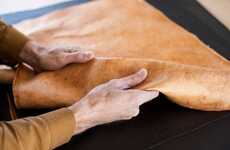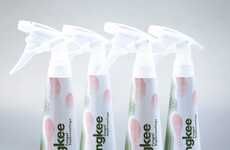
Peelsphere is a Leather Substitute Made from Biomaterial
Elena Rahman — January 12, 2022 — Eco
References: dezeen
Peelsphere was designed by Berlin-based textile specialist Youyang Song. The bio-based material is made from used fruit peels and algae and acts as a leather alternative. The plant-based material is versatile. It is waterproof and can be hardened to form accessories like buttons. On the other hand, it can also remain in its malleable form and be used for bags, gloves, jackets, and more.
The textile designer aimed to create a completely biodegradable substitute material for leather. She succeeded in doing so while mimicking the strength and versatility of animal hide. Peelsphere is made by extracting the fiber and pectin from fruit peels and mixing it together before grinding it into fine pieces. It is then used as a bio-binder and forms sheets of leather-like material.
Image Credit: Youyang Song
The textile designer aimed to create a completely biodegradable substitute material for leather. She succeeded in doing so while mimicking the strength and versatility of animal hide. Peelsphere is made by extracting the fiber and pectin from fruit peels and mixing it together before grinding it into fine pieces. It is then used as a bio-binder and forms sheets of leather-like material.
Image Credit: Youyang Song
Trend Themes
1. Fruit-based Biomaterials - Using fruit peels to create versatile biomaterial offers an opportunity for a sustainable and eco-friendly leather substitute.
2. Biodegradable Textiles - Developing textiles using natural and sustainable materials that can biodegrade provides an opportunity for a more eco-friendly fashion industry.
3. Circular Fashion - Creating a fashion industry that can be circular by using natural or biodegradable materials that can be reused or repurposed will provide a significant disruptive innovation and opportunity.
Industry Implications
1. Fashion and Textile Industry - The fashion and textile industry can explore the use of fruit-based biomaterials and biodegradable textiles to offer sustainable and eco-friendly products to customers.
2. Sustainability Industry - The sustainability industry can introduce new methods and technologies to develop eco-friendly and biodegradable materials which can be used for mainstream fashion and textile production.
3. Agriculture Industry - The agriculture industry can collaborate with designers and textile manufacturers to put the waste from fruit peels to use for creating new biomaterials and eco-friendly products.
7
Score
Popularity
Activity
Freshness























